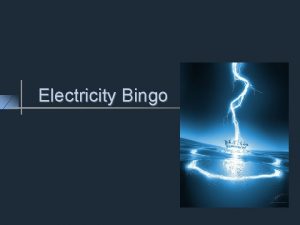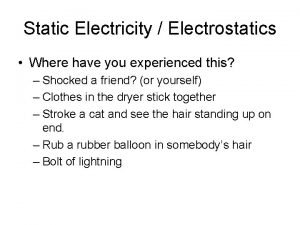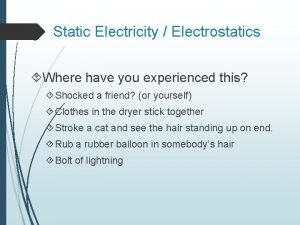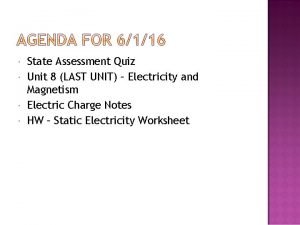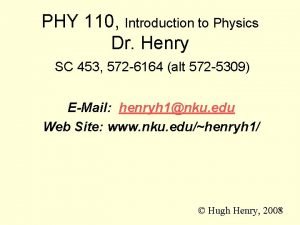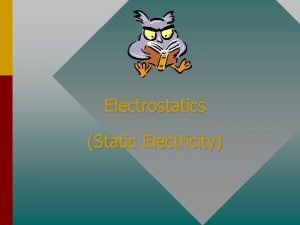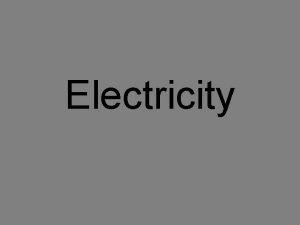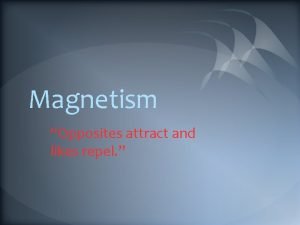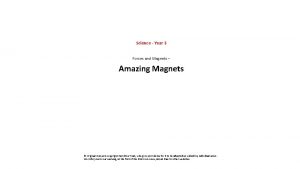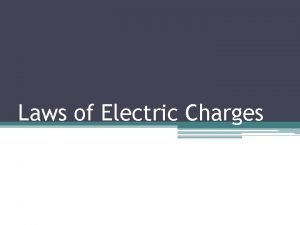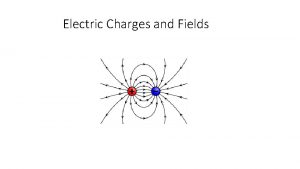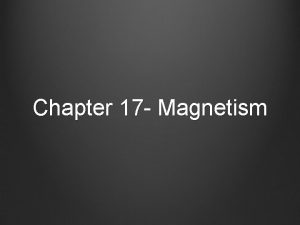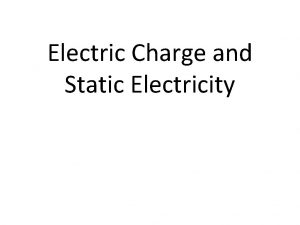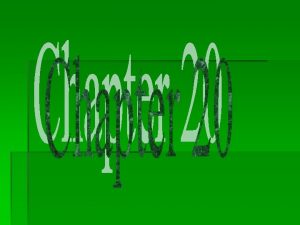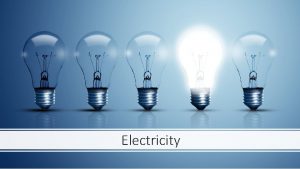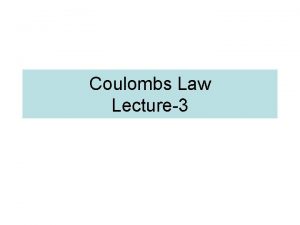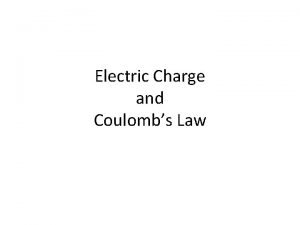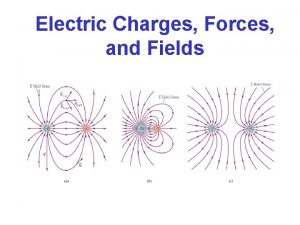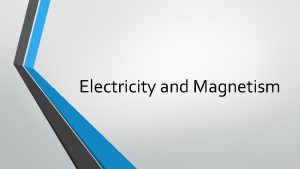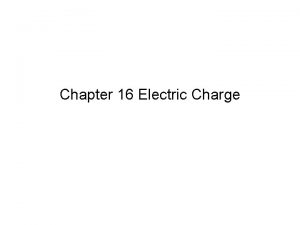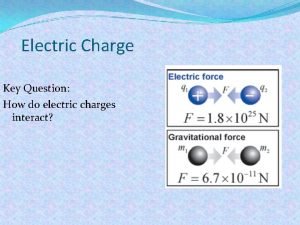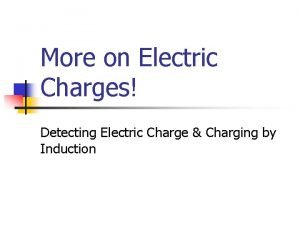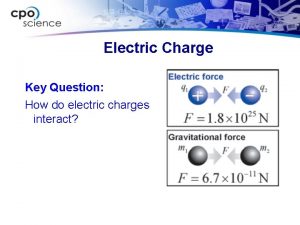Electric Charge Like charges REPEL and Opposite charges















- Slides: 15


Electric Charge • Like charges REPEL and Opposite charges ATTRACT • Only 2 types of charges in the universe + and Fpos + Fneg Symbol: q or Q Unit: C (Coulombs) -

2 Methods of Charging 1. Conduction: charging by CONTACT. Touching two objects together, the electrons from one are transferred to the other

Electric Charge If we are talking about a SINGLE charged particle such as 1 electron or 1 proton we are referring to an ELEMENTARY charge and often use, e , to symbolize this. Particle Charge (C) Mass(kg) Electron -1. 60 x 10 -19 9. 1 x 10 -31 Proton 1. 60 x 10 1. 67 x 10 Neutron 0 -19 -27 1. 67 x 10 -27

2 Methods of Charging 1. Induction: charging by proximity. charges can jump to objects through virtually any medium…. . even a vacuum !

Conservation of charge read only Charges can not be created or destroyed. They transfer themselves between objects in an effort to achieve electric equilibrium where the net charge equals zero! A bolt of lightning can travel at a speed of 45 km/s (100, 000 mph, 160000 km/h). . Grounded: when an object is connected to the earth by a wire, pipe, finger, etc so that electrons can transfer to or from the earth. Why connect to the Earth? The earth is so large that we say it can ACCEPT or DONATE an unlimited amount of electrons.

Charge is “CONSERVED” Charge cannot be created or destroyed only transferred from one object to another. Even though these 2 charges attract initially, they repel after touching. Notice the NET charge stays the same.

Induction and Grounding read only We bring a negatively charged rod near a neutral sphere. The protons in the sphere localize near the rod, while the electrons are repelled to the other side of the sphere. A wire can then be brought in contact with the negative side and allowed to touch the GROUND. The electrons will always move towards a more massive objects to increase separation from other electrons, leaving a NET positive sphere behind.

What How can makes a solid object change its charge? Easy… Read only an object (+) or (-)? - + …moving valence electrons!

Rabbit fur vs rubber rod Physical Example of electrons moving Ex: Rubbing rabbit fur with a rod. • The rod gains electrons from the rabbit fur • the rod becomes negatively charged, the fur becomes positively charged • Opposite charges attract! + -+ + - + -+ + before - - + + + after

Coulomb’s Law 1. Electric Force- the force between any two charges (or charged objects) Attractive = - F Repulsive = +F q= charge 1 q = charge 2 r= radial displacement 2 2. Coulomb’s constant (1/ 4 pe 0) is k= 9. 0 x 10 9 N m 2/C 2 3. Relationship between F and distance is an Inverse Square Law. • Double the distance and Fe will be 1/4 as large.

Electric Force READ ONLY Fe always acts along a straight line between two charged objects. Always draw the force ON the object you’re talking about. Fe is a FIELD FORCE. q 1 Def: A force that acts on objects at a distance; * NO CONTACT. Another Example: Gravitational Force (Fg) + F 2, 1 - Differences: a. Fg is only attractive; Fe can be attractive or repulsive b. Fg is a relatively weak force; Fe is very strong. q 2

Superposition- Net Electric Force If there are more than 2 charges, the net electric force on any charge is found by getting the vector sum of all electric forces. **Draw all forces directly on the charge that you are finding the net force on. 1 -Dimension: forces in same direction are ADDED forces in the opposite direction are SUBTRACTED- (right - left) *if you draw it correctly, do not use negatives in coulomb’s law formula!* Fc, b + + A B + - A B Net force on Charge C: - Fc, a C - Fc, a + Fc, b C Fc, b -Fc, b _ Fc, a

Coulomb (C) is unit of charge…. the Vehicle But Stopping what does that mean? Work is required to bring that Coulombvehicle : (n) to. A a. Coulomb the stop. Work is is a 18 product of force distance charge of 6. 25 x 10 over electrons! OR force times distance, as So if 1 erepresented = 1. 6 x 10 in-19 the C following then equation: 1 e /1. 6 x 10 -19 C = 6. 25 x 10 18 e /C

Superposition- Net Electric Force 2 -Dimensions: Add up all the x’s, add up all the y’s and get the RESULTANT. Fb, c B C - - Fb, a + A Net force on Charge B:
 Like charges blank and opposite charges blank
Like charges blank and opposite charges blank Joules in us units
Joules in us units Like charges attract or repel
Like charges attract or repel Like charges attract or repel
Like charges attract or repel Like charges attract or repel
Like charges attract or repel Like charges attract or repel
Like charges attract or repel Electric charges and electric forces lesson outline
Electric charges and electric forces lesson outline Difference between charge and electric charge
Difference between charge and electric charge Difference between static and current electricity
Difference between static and current electricity Chapter 21 electric charge and electric field
Chapter 21 electric charge and electric field Chapter 21 electric charge and electric field
Chapter 21 electric charge and electric field Unit of charge
Unit of charge Chapter 21 electric charge and electric field
Chapter 21 electric charge and electric field Opposite charges attract.
Opposite charges attract. Magnetic opposites attract
Magnetic opposites attract Attract repel
Attract repel
